I love wine with food. More and more Americans are discovering just how enjoyable combining wine and food is. While Europeans have know the pleasures of wine and food for centuries, it is a relatively new experience for we "New Worlders". In this regard, I have had the advantage of being of Italian descent, my paternal grandparents being Italian immigrants and my maternal great-grandparents likewise so. Thus, wine is something that was fairly common at the dinner table for me as a child. I cannot say however, that it was anything like you would find in Europe. Although my paternal grandfather made wine annually and drank it as you would find in Italy, my father did not follow suit. The product of a time in this country when being an Italian immigrant was not as glamorous as it may seem to me now, he and his siblings endeavored to be more "American" than Italian. He was much More likely to have enjoyed a beer with dinner or a ginger ale for that matter. My mother is another story. She has loved wine as long as I can remember. Well wine in the sense of fermented grapes. She enjoyed, and still enjoys the Italian homemade style wines. These wines are far from what you would consider "fine wine". The commercial equivalent of these are jug wines like Fortissimo or Piasano. While I can say that I cut my teeth on these wines, they are not what I strive to grow and make. I have become somewhat of the family wine snob, tasting my way through these jug wines on up to California Merlots of the late 80's, later Cabernet's and eventually finding my palate planted in old world wines like Chianti, Barolos, Super-Tuscans and Bordeauxs.

My discoveries in fine wine also led me to enjoying wine and food pairings. I started with the usual Cabernet or Merlot with red meat. Sauvignon Blanc or Riesling with seafood. Chianti with pasta and Chardonnay with poultry. It has always amazed me the way wine can enhance, or be enhanced by different food pairings. Have you ever tried good dry, champagne and then taken a bite of a ripe, sweet strawberry and tasted the champagne again? You will be amazed at how the flavors compliment each other. I just can't seem to get enough of these pairings. I love them so much that I have, in my quest for deliciousness, begun to break the rules. What I mean is I now regularly fore go the usual wine and food pairings and try my own combinations. I might drink a Chianti with fettuccine alfredo or Viognier with pasta and meat sauce. How about Zinfandel and seafood fra diavolo. When I'm with "wine snob" friends or at "fancy" restaurants this often causes an eyebrow or two to raise. I might incur the ire of a "connoisseur" or other aficionado. You know what I say? Who really cares! I don't. I don't make or drink wine because I want to impress some self proclaimed Robert Parker. I drink it because I truly enjoy this wonderful and mysterious nectar of fermented grapes. I try it with foods that I love and if I find a pairing that isn't status quo then I guess I'm a pioneer. This is why I make wine. My wife loves to cook and experiment with recipes. I love the excitement of coming home and finding her cooking a delicious meal. It is so nice going down to my cellar and having enough different wines so I can try and pick one that will be the perfect compliment to her meal.
Hence the beauty of wine and food pairings. There is just so much variety. Don't get me wrong, I love Riesling and seafood. It's just that in my mind there are endless possibilities when it comes to pairings. You could think of a new one every day of your life. Some won't work and some will be amazing. I just hope I live long enough to experience as many different combinations of wine and food as possible. I guess I'll have to live forever.















